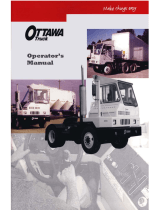
WARNING Whipping discharge hose
A discharge hose that comes loose can lash around,
and the hose or jets of liquid can hit the operator,
and cause personal injury or death. To reduce this
risk:
► Always remove kinks, before the pump is started.
If the discharge hose is kinked, it can be forced
out of the operator's hands.
► Always make sure that the discharge hose
connections are properly attached.
► Check that the discharge hose and the
connections are not damaged, replace if
necessary.
► Always make sure that the outlet end of the
discharge hose is properly secured.
WARNING Fixed installation hazard
The pump is primarily intended for use in temporary
(mobile) applications. If the pump is used in a fixed
installation, the connections between pump and
pipe can come loose and jets of liquid or other
particles can hit the operator, and cause personal
injury or death.
► Always use a flexible hose in connections between
pump and pipe.
► Never hang the pump by its hose.
Operation, precautions
DANGER Explosion hazard
If a pump comes into contact with explosives or
explosive gases, an explosion could occur. When
using certain materials in machine parts, sparks and
ignition can occur. Explosions will lead to severe
injuries or death.
► Never operate the machine in any explosive
environment.
WARNING Hot pump
If hot liquid is being pumped, the pump can become
hot. Touching a hot pump can lead to burns and
personal injury.
► Avoid touching the pump if hot liquid is being
pumped.
WARNING Flammable liquid hazard
If flammable liquid is being pumped, the fumes can
explode when ignited. This can lead to personal
injury or death.
► Never pump flammable liquids.
WARNING Emergency stop hazard
If an emergency situation occurs while pumping,
and the pump is not stopped immediately, personal
injury or death can occur.
► Install an on/off valve on the air supply hose, as
close to the pump as possible.
► Activate the on/off valve if an emergency situation
occurs.
WARNING Level of pumped medium
hazard
If the level of the pumped medium is above the
muffler level, the pumped medium will be mixed
with the exhaust air and personal injury or death
can occur.
► Never place the pump in such a way that the level
of the pumped medium is above the muffler level.
WARNING Unexpected movements
When in use, the pump may unexpectedly move.
Accessories may break due to fatigue after a certain
amount of use. Sudden and unexpected movement
can cause injuries. Furthermore, losing your balance
or slipping may cause injury.
► Pay attention not to lose your balance when
submerging or taking the pump out of the liquid,
use a proper lifting device.
► Always inspect the equipment prior to use. Never
use the equipment if you suspect that it is
damaged.
► Make sure that the pump and its accessories are
clean and free of grease and oil.
► Moving parts may crush and cut, never check
bores or passages with hands or fingers.
► Never strike or abuse the equipment.
► Check regularly for wear on the accessories, and
check whether there are any signs of damage or
visible cracks.
► Pay attention and look at what you are doing.
WARNING Projectiles
During operating, particles or jets of liquid may
become projectiles and cause personal injury by
striking the operator or other persons. To reduce
these risk:
► Use approved personal protective equipment and
safety helmet, including impact resistant eye
protection with side protection.
► Make sure that no unauthorised persons trespass
into the working zone.
► Keep the workplace free from foreign objects.
79800 0556 90c | Original instructions
Safety and operating instructionsCP 0077



















